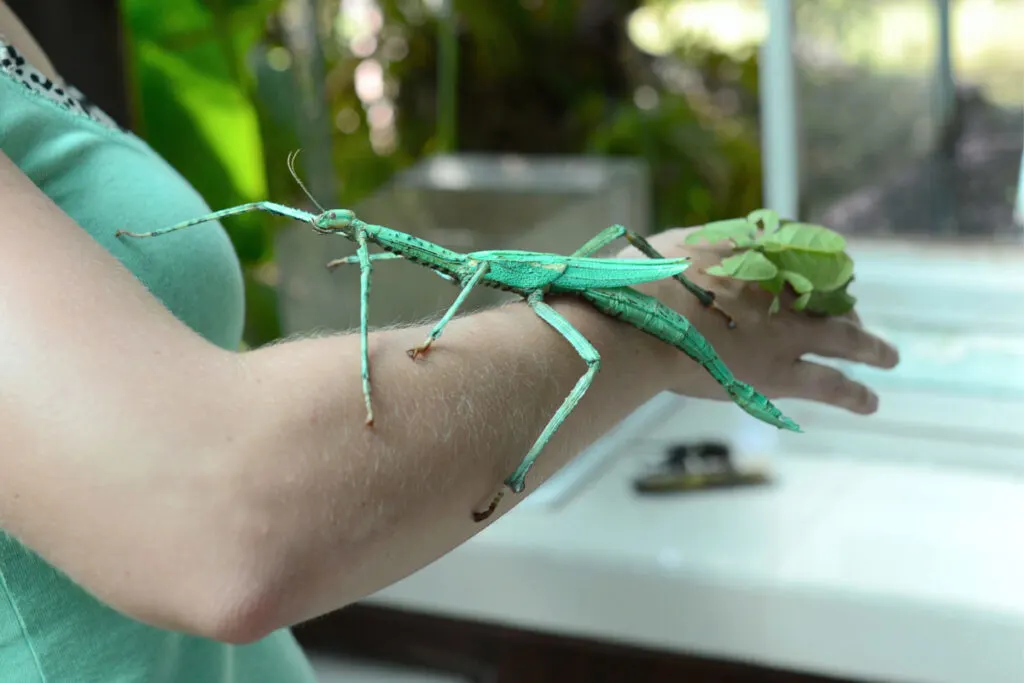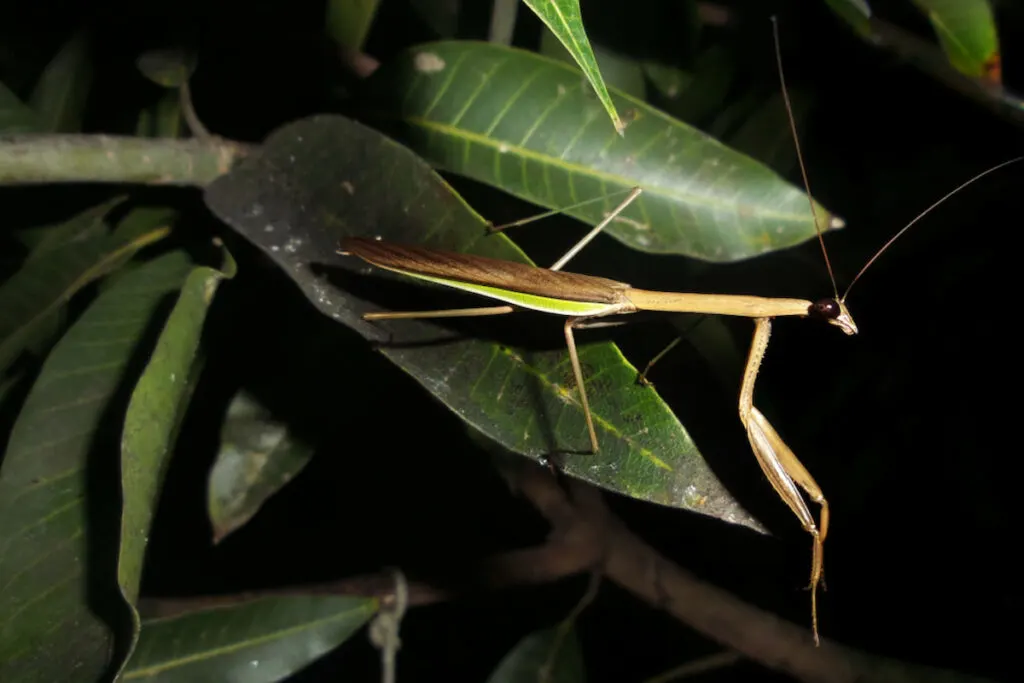Something that separates stick insects from other insects is their natural ability to blend in with their surroundings and look like a slender, long woody plant. This is also why these phasmids are called walking sticks, stick bugs, stick animals, bug sticks, and ghost insects.
As members of the order Phasmatodea, they generally can be found inhabiting subtropical habitats and spend most of their time among the leaves, plants, and even on the forest floor.
You may wonder if they are like other insects in other ways.
Do stick insects have wings? And do they fly?
Most adult, full-grown stick insects have wings. However, not all winged species fly and if they do, they don’t fly often.
Not to mention, stick insects that have wings and fly are mostly male adult phasmids. Depending on each species, their wing sizes might vary and most possess a reduced wing size.

Table of Contents
The Roles of Wings In Stick Insects
Insects fly for different reasons. For some species, flight is their means of movement while for others, it could be a response to danger and protection from predators.
As for stick insects, they fly mainly for food, to avoid threats, and for mating purposes.
The evolution of winged phasmids also happens with respect to the natural habitat they live in. You will find that most species that live in a rich habitat with fewer predators don’t have wings or the wings they have are under-developed. However, around 40 percent out of 3,000 species of phasmids are fully winged.
In stick insects, wing dimorphism (differences between male and female insects) happens for a few reasons. This is also why only most male phasmids have wings.
Due to their large body sizes, stick insects don’t move fast or travel far in one go. In some cases, they will travel quite a distance to find female phasmids in their mating season. Most male phasmids also don’t have a long lifespan. Hence, this is why they need wings to find their potential mates and breed.
In some species, male-to-male competition also happens to compete for a mating partner and territory. Unlike the females that don’t have to compete, these males generally have fully-developed wings.
When some smaller phasmids can’t fight, their wings will help them to fly away and save themselves from the threat of other phasmids.
9 Species of Winged Stick Insects That Can Fly
Here are some of the popular species of winged stick insects that can fly:
Jungle Nymph (Heteropteryx dilatata)

Jungle nymphs are native to the tropical forests of Malaysia. They are also known as the Malayan jungle nymph, Malaysian stick insect, Malayan wood nymph, and Malaysian wood nymph. These large stick insects are the heaviest species of all stick insects that weigh between 1.06 and 2.3 ounces.
The females are much larger than the males and measure between 5.5 and 6.7 inches. Meanwhile, males are slender and typically grow between 3.5 to 5.1 inches. These nocturnal phasmids also hold the world record for the largest egg laid by insects at 0.5 inches in length.
Javanese Lichen Stick Insect (Pseudodiacantha macklotti)
These stick insects can be commonly found in Asian tropical regions, Java, Bogor, and Malaysia. They have sturdy, medium-sized bodies that measure between 2.6 and 2.9 inches. The females have brown or bark-like coloration on their bodies, whereas males have slightly duller colors.
Javanese lichen stick insects are nocturnal. They can easily be bred and the females release around 5 eggs per week. In the presence of danger, adult females will generally flash their red-black wings as a defense mechanism. They also release a smelly odor to deter their predators.
Goliath Stick Insect (Eurycnema goliath)

Goliath stick insects are endemic to Australia and can be found throughout Northern Australia, Western Australia, into New South Wales, and Victoria. They are also known as regal stick insects.
These enormous phasmids possess bright green bodies with yellow patches on the legs, thorax, and heads. They grow up to 10 inches in length with the females slightly larger and heavier than the males.
Although they don’t fly, the wings of the females act as a parachute whenever they suddenly fall from higher places.
Even if they haven’t mated with the males, female Goliath stick insects can lay viable eggs through a process called parthenogenesis.
Yellow Flying Stick Insect (Necroscia annulipes)
These stick insects originated in Malaysia and they are mostly being raised or kept as pets due to their beautiful colors. Like their name, yellow flying stick insects have yellow to light green coloration with long, black and white striped antennae, and two sets of front legs that are striped in black and yellow.
They have two sets of wings, which are small and large wings. The large wings are used to fly.
Similar to other species, the females are slightly larger than the males and grow up to 4 inches in length. Meanwhile, the males only grow up to 3 inches in length. From a quick glance, the sexes might look similar but the males are smaller and thinner than the females.
Asceles tanarata
Asceles tanarata can be found in tropical regions and high-altitude mossy forests, specifically in Singapore and Peninsular Malaysia.
As of today, there is not much information recorded about this species. However, you can find three subspecies of Asceles tanarata including Asceles tanarata amplior, Asceles tanarata singapura, and Asceles tanarata tanarata.
Children’s Stick Insect (Tropidoderus childrenii)

These unique and large stick insects are native to Eastern Australia and can be commonly found throughout New South Wales, the Eastern Coast of Queensland, and Victoria.
Children’s stick insects are also known as yellow-winged specters. They generally grow up to 4.3 inches in length and wings can be found in both males and females.
The females come in different colors ranging from apple-green, cream, light pink, to purple, with yellow-tinted wings and blue-yellow coloration on the segment of their bodies.
Meanwhile, the males have light-reddish brown bodies. But due to their slender and light bodies, the males will actively fly from tree to tree in search of their potential mates.
Pink-winged Stick Insect (Sipyloidea sipylus)

Pink-winged stick insects are endemic to Australia. Although they originated in Madagascar, they can be commonly found in the Murray-Darling basin, along the South-East coast, and in New South Wales.
They are often mistaken with the Indian stick insects because of their same body shapes and sizes. However, pink-winged stick insects have slightly lighter brown bodies when they are fully mature. These large stick insects can grow up to 4.3 inches in length.
Giant Prickly Stick Insect (Extatosoma tiaratum)

These large, ornate-looking stick insects are the most unique species out of the flying stick insects. They are also known as the Macleay’s specters, Australian walking sticks, and spiny leaf insects. Giant prickly stick insects can be found in the tropical forests of northern Australia and New Guinea.
They can be characterized by their thick bodies, lobed limbs, and small spines covering all their bodies. These stick insects come in different colors ranging from light to mid-brown, dark brown, green, to beige.
The females grow up to 6 inches in length and are much bulkier and larger than the males. Meanwhile, the males measure between 4.7 and 5 inches and are much smaller and slender. However, the adult males can fly with their large wings while the females can’t.
Orange-Winged Stick Insect (Pseudophasma rufipes)
Pseudphasma rufipes can be commonly found in Peru. They are also known as orange-winged stick insects. They come in woody-like or rusty brown colors that resemble tree bark or dried sticks.
As of today, there is not much data recorded about this species.
Final Thoughts
Overall, there are more than 3,000 different species of phasmids that exist all around the world. The assumption that stick insects don’t have wings and can’t fly is certainly far from the truth.
There are some that do fly but that happens as a part of their defense mechanism to get away from predators and external threats. And they are generally found out in the wild. Stick insects that are kept as pets mostly can’t fly.
Citations
- https://keepingbugs.com/do-stick-bugs-fly/
- https://www.justexoticpets.com/can-stick-insects-fly/
- https://www.thoughtco.com/fascinating-facts-about-stick-insects-1968575
- https://www.thesprucepets.com/stick-insects-as-pets-1236887
- https://www.keepinginsects.com/stick-insect/species/jungle-nymph/
- http://www.phasmatodea.com/pseudodiacantha-macklottii-java
- https://bugsed.com/goliath-stick-insect
- https://www.keepinginsects.com/stick-insect/species/necroscia-annulipes-psg-290/
- https://bugsed.com/childrens-stick-insect
- http://coolpetbugs.com/pink-wing-stick-insect-care-sipyloidea-sipylus/
- https://www.georgiaaquarium.org/animal/giant-prickly-stick-insect/
